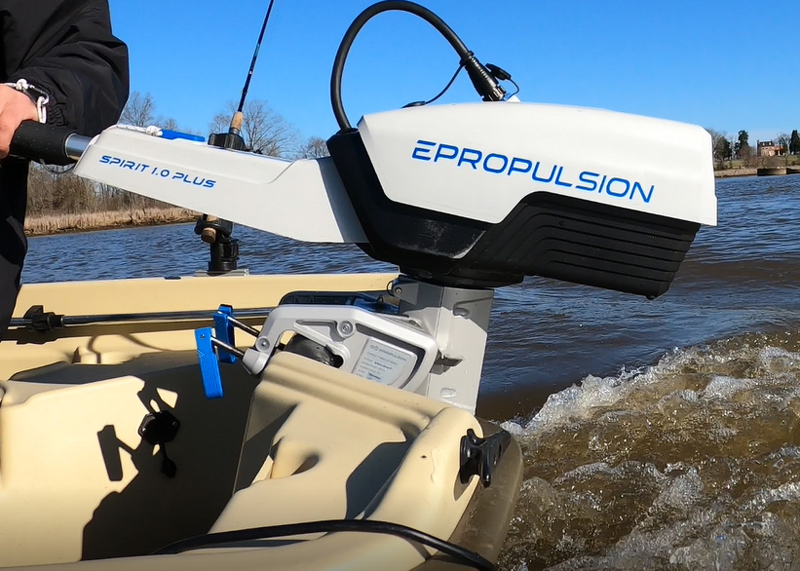If you enjoy Chesapeake Bay fishing from a boat, chances are you depend on lead-acid batteries to crank over that boat’s engine, power your electric trolling motor, and feed juice to everything from fishfinders to radar — and chances are also pretty good that you’ve cursed those infernal juice-boxes more than a few times. They run out of power when you need them most, weigh approximately 16 tons each, and rarely last more than a handful of years before requiring replacement. Meanwhile, oodles of hip folks are zipping around town on cars powered by… batteries? Wait a sec — what gives? How is it possible for batteries to power a car, when we can barely depend on them to crank over a six-cylinder outboard without fail?

There are a number of reasons, the first being battery tech. As usual, the marine world is a light-year or three behind the rest of the universe, tech-wise. But as for powering boats entirely with batteries versus fossil fuels the bigger problem is the amount of energy it takes to move a boat over water versus a car over land. Boats don’t have wheels, nor do they enjoy the benefits of regenerative braking. So, even if we had the latest and greatest batteries aboard they still wouldn’t be able to match the range and performance we get via good ‘ol internal combustion.
Powerful Battery Power Computations
Basic chemistry is the culprit. Measuring energy density (gravimetric energy density, for you uber-picky tech-terminology types) in megajoules per kilogram (MJ/kg), gasoline can hold around 46 MJ/kg. A lead-acid battery can only swing a meager 0.14 MJ/kg. In layman’s terms, every pound of gasoline you haul around can produce well over 300 times as much energy as every pound of conventional-tech battery. Yikes.
The reason for this disparity? Organic chemicals such as gasoline, butane, and even carbohydrates, can store a lot more chemical potential energy than we’re able to stuff into a similarly sized manmade power cell. For example, a roast beef sandwich has a battery-beating energy density of about 11 MJ/kg. Unless you're planning on rowing your boat the viability of sandwich-powered propulsion is questionable at best, but it just goes to show how much potential energy is locked inside organic material versus our attempt to store that energy in a box.
Who would buy a 150-hp electric motor that needed to haul 90,000 pounds of batteries to carry as much power as a 50-gallon fuel tank? No one. Although to be fair, given that electric motors are roughly twice as efficient as internal combustion engines, figuring on 45,000 or so pounds of batteries would be more realistic. Still, it’s a losing proposition.
But times and tech change, and in the 1990s lithium-ion batteries that could stow more like 0.5 or even 0.7 MJ/kg hit the scene. That still left a huge gap behind gas but the five-fold increase in energy density over lead-acid power packs was obviously a huge leap forward. By the mid-2000s lithium-ions were in widespread use on land and even made their way into a few boats, but there was one slight drawback. You know, that whole issue with them blowing up, which the science geeks helpfully termed “thermal runaway.” While it was problematic enough on land, at sea the danger factor was simply unacceptable.

If you’ve seen that cryptic “LiFePO4” stamped on a newer battery, you already know what happened next. Responding to safety concerns much of the industry turned to lithium iron phosphate batteries, which utilize an iron phosphate cathode as opposed to the lithium magnesium oxide or lithium cobalt dioxide cathode found in other lithium-ions. That may cause an energy density drop of around 15 percent, but the cathode doesn’t burn or explode when overcharged or overheated. And if avoiding that whole thermal runaway thing isn’t tempting enough for you, they also have an advantage in that they last longer. LiFePO4 can live through around four times as many discharges and recharges than the older lithium-ions. Plus, did we mention that they don’t blow up?
Better Batteries for Boats
Along with LiFePO4s came a new generation of electric outboards from the likes of Torqeedo and ePropulsion. With dedicated clip-on power packs shaped more or less like the cowl of an outboard and designed for specific motors in the one- to three-horsepower range, these mini-mites tripled or even quadrupled range while halving weight as compared to traditional electric motors powered by lead-acid batteries. Torqeedo took things a step farther, building motors up to 80-hp designed to run on the 360-volt, 40 watt-hour battery developed for the BMW i3.

Still, despite these advances larger boats don’t get in on the game via their main propulsion system — even the monster lithiums can only provide enough juice to cruise at planing speeds for relatively limited distances. But more and more of us enjoy their benefits in the form of bow-mounted electric trolling motors. A single 36-volt, 60 amp-hour battery weighs less than half of a bank of lead-acid 12-volt batteries while providing twice as much run-time. You can drop your Minn Kota down, Spot-Lock a 26-foot boat in place in a 10-knot breeze all day long, and come home with over half of your capacity still contained in that box of magic. Plus, these LiFePO4s will live for a heap of years instead of a handful.

Case in point: on my Caymas 26 HB I opted for a single 36-volt LiFePO4 to power the Minn Kota perched on the bow, and try as I might I simply can’t use the thing up during a day of fishing. I’ve had the boat Spot-Locked in place for hours at a time including in winds of 15 to 20 mph, and used it to power across huge areas of productive bottom. Yet at the end of the day the battery meter has yet to read below 75-percent charge.
Boat Batteries of the Future
So, will battery-powered boats replace our dinosaur-chugging towers of power? Not anytime soon, at least not with motors large enough to power anything beyond a Jon boat. That whole energy density thing remains problematic, and even purpose-built electric boats tend to have cruising speeds in the low 20s and ranges measured in dozens, not hundreds, of miles. Once horsepower ranges reach into double-digits the power-packs they require become too large and heavy to be portable.
The best-looking fishing boat case subject at this point is probably the Epoch Skiff, in 14- and 18- foot models, which cruises on foils to reduce drag, can be powered with 15- to 25-hp motors, and carries a five-kWh battery. Still in the testing phase, Epoch claims a range of around 20 miles when run at its 30 mph top-end. That’s a lot better than most electric rigs we’ve seen in the past, but still far short of what you could do with a gasoline-burning outboard and a fuel tank.
Note: we haven’t even broached the subject of cost yet. That 36-volt, 60 amp-hour battery that works out so well on boats with electric trolling motors? It’ll cost you over $1700, as compared to $500 or so for lead-acid. That BMW i3 battery? It goes for about as much as an entire Nissan Sentra. The 14-foot Epoch? Figure in the neighborhood of $35K. For a 14-footer.
Still, the tremendous advantages of LiFePO4 batteries over lead-acid are obvious. And huge. And continue to grow, year by year. Or, you could look at all of these factors and decide that kayak fishing is more your speed. From the cost and environmental perspectives, it certainly does make sense. Just remember to pack plenty of 11 MJ/kg roast beef sandwiches.